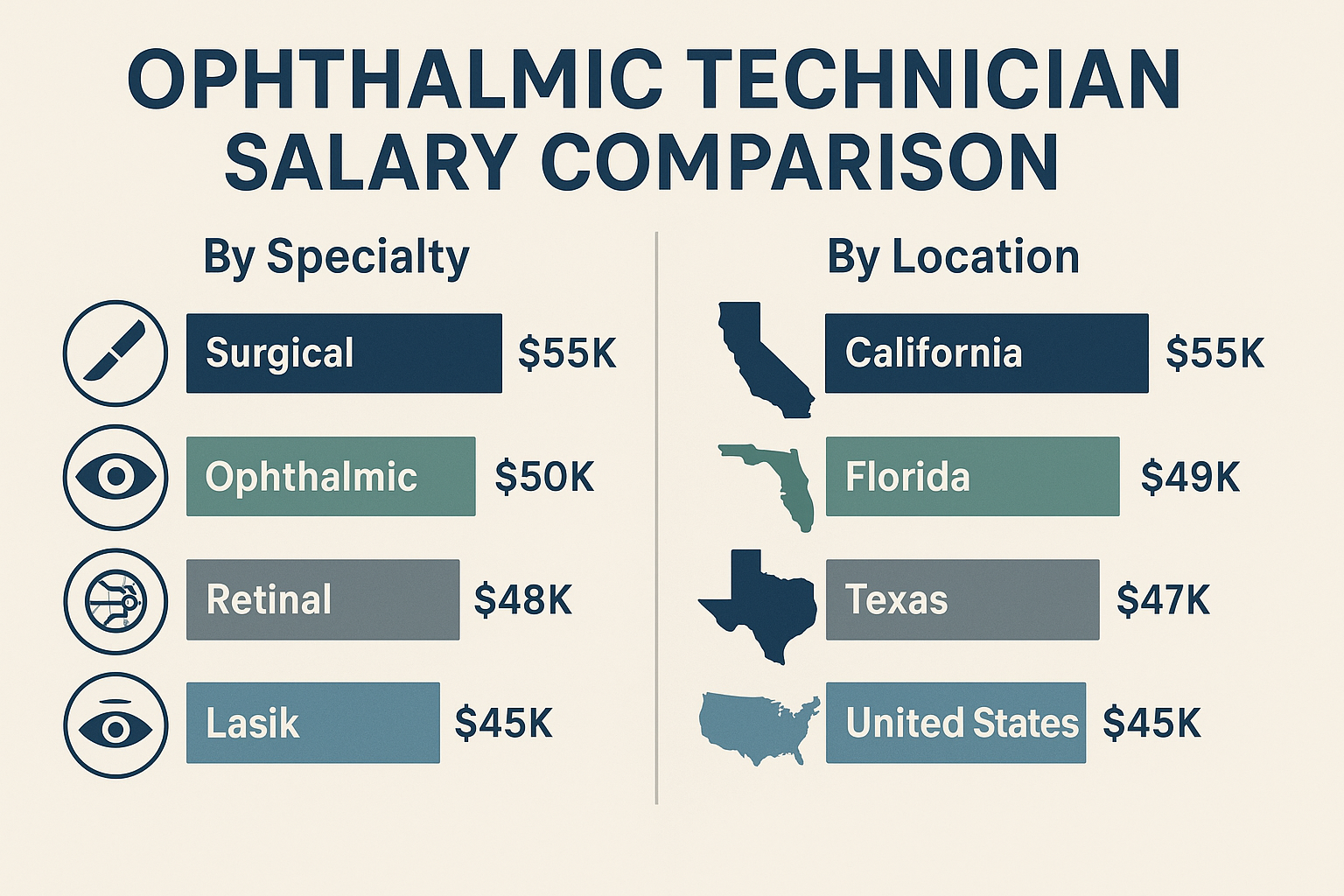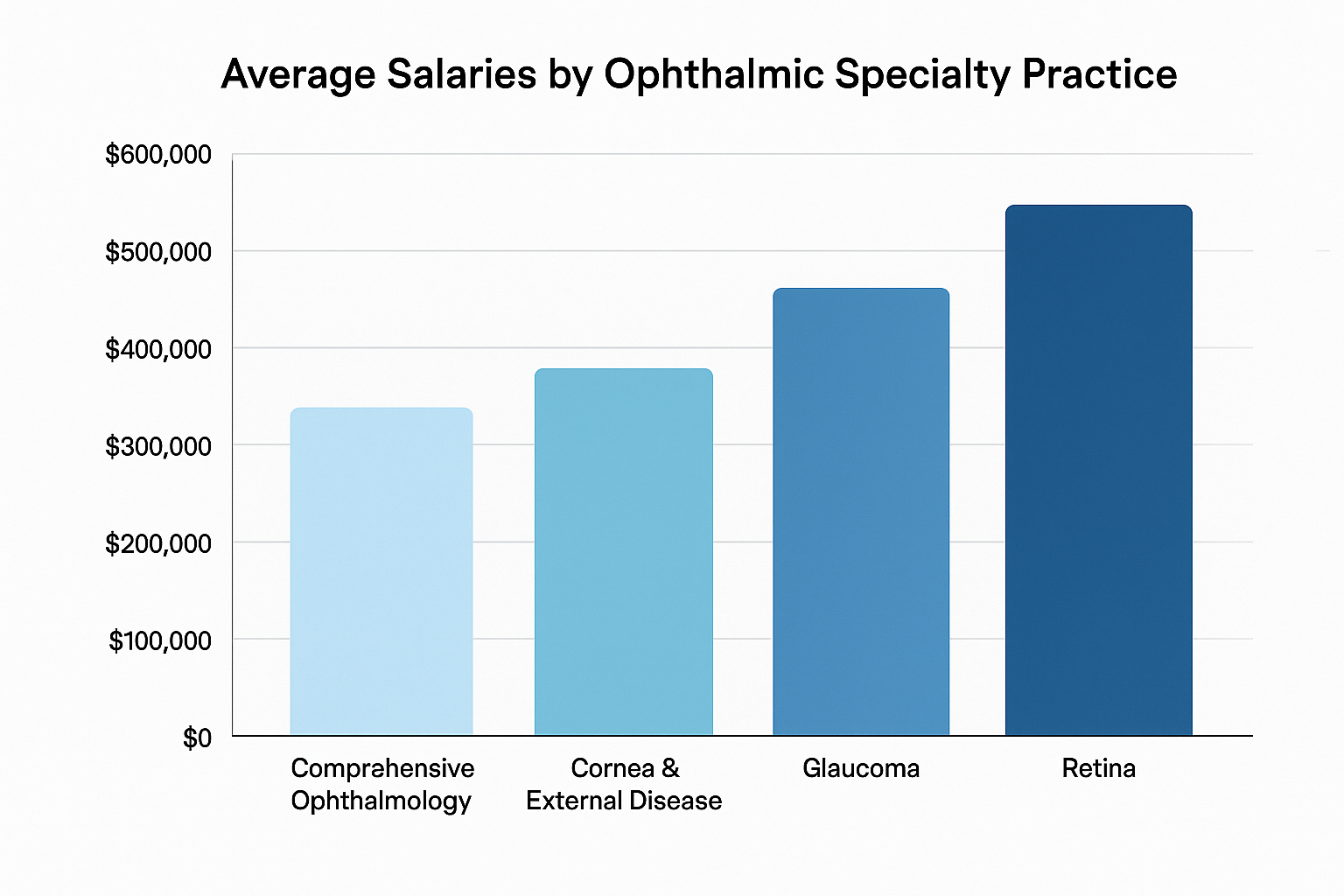Most ophthalmic technicians are leaving serious money on the table because they’re focusing on the wrong factors when it comes to maximizing their earning potential. I’ve discovered that understanding geographic salary arbitrage, specialty practice premiums, and hidden compensation streams can dramatically increase your total compensation – sometimes by 50% or more.
The U.S. Bureau of Labor Statistics predicts a 12 percent increase in ophthalmic technician positions between 2020 and 2030—faster than the national average for all occupations. This isn’t about working harder; it’s about working smarter and positioning yourself in the right markets with the right skills.
With demand for skilled professionals at an all-time high, I want to share what I’ve learned about maximizing your ophthalmic technician salary through strategic positioning rather than just grinding it out year after year.
Table of Contents
- The Geographic Money Game: Why Your ZIP Code Determines Your Paycheck
- Beyond Base Pay: The Hidden Money Most Techs Never See
- Your Career Roadmap to Six-Figure Potential
- Future-Proofing Your Income in a Changing Industry
- Action Steps to Maximize Your Earning Power
TL;DR – The Money Moves That Matter
- Secondary markets like Phoenix and Nashville offer 85-90% of big city salaries with 60-70% of the living costs
- Retinal specialty practices pay up to 40-50% more than general ophthalmology
- COT certification typically increases salary by 15-25% over COA level
- Rural positions often include signing bonuses and benefits that exceed urban base salaries by 15-20%
- Surgical centers pay 20-30% more than general practices due to higher patient volumes
- Cross-training in multiple specialties can increase overtime opportunities and hourly rates
- Management track positions can boost compensation by 30-50% beyond clinical roles
- Technology integration skills are becoming premium qualifications as AI transforms the field

The Geographic Money Game: Why Your ZIP Code Determines Your Paycheck
Your location has more impact on your ophthalmic technician salary than your years of experience, and most people are thinking about this completely wrong. While everyone chases jobs in expensive major cities, the real money is often in secondary markets where you get nearly the same salary but pay way less for everything else.
I’ve seen techs increase their effective income by 30% just by moving to the right city. Rural positions are offering incentives that can beat urban salaries outright. When you’re wondering how much do ophthalmic technicians make, the answer depends heavily on where you’re asking the question.
The data tells a compelling story about ophthalmic opportunities across different markets:
| State | Average Annual Salary | Cost of Living Rank | Effective Purchasing Power |
|---|---|---|---|
| Alaska | $56,890 | High (Top 10) | Moderate |
| Minnesota | $53,250 | 26th | High |
| California | $51,010 | High (Top 5) | Low-Moderate |
| North Carolina | $38,060 | Low-Moderate | High |
| Phoenix, AZ | $37,400 | Moderate | High |
Source: Medical Technology Schools and BLS May 2021 data.
The Sweet Spot Cities Nobody Talks About
Major metropolitan areas aren’t always the goldmine they appear to be when you factor in what you’ll actually take home after rent, taxes, and daily expenses. The real opportunities are hiding in mid-tier markets where healthcare systems are competing for talent but housing costs haven’t exploded yet.
These cities offer the perfect storm of decent salaries and reasonable living costs. Understanding the true value of your credentials becomes crucial when evaluating opportunities across different markets, especially when considering replacing a lost diploma for verification purposes in new locations.

Secondary Markets Where Your Dollar Goes Further
Cities like Phoenix, Nashville, and Austin have become the secret weapons for smart ophthalmic technicians who want to maximize their purchasing power. You’re looking at 85-90% of what you’d make in New York or San Francisco, but your rent might be half the price. The math works out to significantly more money in your pocket every month.
Consider Sarah, an ophthalmic technician who moved from Los Angeles ($47,720 annually) to Phoenix ($37,400 annually). While her salary dropped by $10,320, her rent decreased from $2,800 to $1,400 monthly, saving her $16,800 annually. Her effective income increased by over $6,000 per year, plus she gained a shorter commute and lower overall living expenses.
Phoenix-Mesa-Scottsdale employs 1,640 ophthalmic technicians earning an average of $37,400 annually, while Los Angeles-Long Beach-Anaheim employs 1,580 technicians earning $47,720 annually, according to Medical Technology Schools. The numbers don’t lie – sometimes less is actually more.
Rural Recruitment Gold Rush
Rural hospitals and clinics are getting creative with compensation packages because they’re struggling to attract qualified technicians. We’re talking signing bonuses, student loan forgiveness programs, and housing assistance that can add up to 15-20% more than what you’d make in the city.
Some facilities are even offering relocation packages and guaranteed hours. When relocating for these opportunities, having proper documentation ready is essential, and many professionals find themselves needing to get a diploma replacement quickly to meet hiring requirements in new markets.
Healthcare facilities are increasingly investing in their ophthalmic staff. As reported by UConn Today, UConn Health adjusted the salaries of its ophthalmology technicians in August 2022 to improve recruitment and retention by putting them more in line with the market, recognizing that skilled technicians are essential to quality patient care.
Specialty Practices: Where the Real Money Lives
Different subspecialties have vastly different profit margins and patient volumes, which translates directly to what they can afford to pay their staff. Understanding these differences can help you target the highest-paying ophthalmic opportunities in your area.
I’ve found that ophthalmic practices in certain specialties consistently outpay others, and it’s worth knowing which ones before you start your job search. The variation in ophthalmic compensation between specialties can be dramatic.

Surgical Centers vs. Regular Practices
Ambulatory surgical centers consistently pay 20-30% more than general ophthalmology practices, and there’s a simple reason why. Higher patient turnover, more complex procedures, and better insurance reimbursements mean these facilities generate more revenue per technician hour. The work might be more intense, but the paycheck reflects it.
Outpatient care centers offer the highest pay at $58,810 annually ($28.27 per hour), while general medical and surgical hospitals pay $51,380 annually ($24.70 per hour), according to Medical Technology Schools.
Research Facilities: The Hidden High-Payers
Clinical research positions in ophthalmology offer some unique compensation perks that most people don’t know about. Beyond competitive base salaries, you’re looking at performance bonuses tied to study enrollment, continuing education allowances, and sometimes even profit-sharing arrangements.
These positions also tend to have more regular hours than clinical practice. Marcus transitioned from a general ophthalmology practice earning $42,000 annually to a university-based research facility. His base salary increased to $51,530, plus he receives $3,000 annually for continuing education, performance bonuses averaging $2,500, and regular business hours with no weekend calls. His total compensation package increased by over $15,000 annually.
Retinal Specialists: The Premium Payers
Retinal practices consistently offer the highest technician salaries in ophthalmology, and it’s not just because the work is specialized. These ophthalmic practices use expensive diagnostic equipment, see complex cases that require more technician time, and often have patients with serious conditions that generate higher billing.
The learning curve is steep, but the compensation reflects the expertise required. The demand for specialized ophthalmic technicians is growing rapidly. TCC Magazine reports that demand for ophthalmic medical personnel is set to grow some 25 percent in the next decade, with advanced positions like certified ophthalmic technicians (COT) commanding salaries between approximately $53,000 and $69,000 according to a 2019 survey from the Association of Technical Personnel in Ophthalmology.

Certification ROI: What’s Actually Worth Your Time and Money
Everyone tells you to get certified, but nobody breaks down which certifications actually pay for themselves and which ones are just expensive pieces of paper. The return on investment varies dramatically depending on which credential you pursue and where you plan to work.
Some certifications can boost your ophthalmic technician salary by thousands annually, while others barely move the needle. When pursuing certifications, understanding replacement certifications processes becomes important for maintaining your credentials throughout your career.
Certification Investment Checklist:
- Research salary premiums for specific certifications in your target market
- Calculate total certification costs including exam fees, study materials, and time investment
- Determine payback period based on salary increase
- Consider employer tuition reimbursement programs
- Factor in career advancement opportunities beyond immediate salary boost
- Evaluate continuing education requirements and ongoing costs
COA to COT: The Upgrade That Pays
Moving from Certified Ophthalmic Assistant (COA) to Certified Ophthalmic Technician (COT) typically results in a 15-25% salary increase, making it one of the best investments you can make in your career. The additional training requirements are manageable, and most employers recognize the higher skill level with immediate compensation adjustments.
When you’re researching ophthalmic medical technician salary ranges, the certification level makes a significant difference. Here’s what the numbers actually look like:
| Certification Level | Average Annual Salary | Hourly Rate | Certification Premium |
|---|---|---|---|
| Non-Certified | $44,724 | $17.60 | Baseline |
| COA (Certified) | $46,835 | $21.37 | +$2,111 (+4.7%) |
| COT (Advanced) | $53,000-$69,000 | $25.48-$33.17 | +$6,165-$22,165 (+13.8-49.6%) |
Source: Medical Technology Schools and Association of Technical Personnel in Ophthalmology 2019 survey.
Specialized Certifications: The Niche Advantage
Additional certifications in areas like OCT imaging, surgical assisting, or specific diagnostic procedures can add $3,000-$8,000 annually to your base compensation. These specialized skills make you more valuable because fewer ophthalmic technicians have them, and practices are willing to pay premiums to avoid training costs and ensure quality.
Jennifer added OCT imaging certification to her COT credentials, which took 40 hours of training and cost $800. Her employer immediately increased her hourly rate from $22 to $25, resulting in an additional $6,240 annually. The certification paid for itself in less than two months, and she became the go-to technician for complex diagnostic cases.

Beyond Base Pay: The Hidden Money Most Techs Never See
Your base salary is just the tip of the iceberg when it comes to total compensation as an ophthalmic technician. I’ve found that benefits, overtime opportunities, and alternative compensation structures can add 25-35% to your effective earnings, but most people don’t know how to evaluate or negotiate these extras.
The key is understanding which employers offer the best total packages and how to position yourself for maximum earning potential beyond your regular paycheck. When people ask how much do ophthalmic technicians make, they’re usually only thinking about base salary – which is a mistake.
Benefits That Actually Add Up to Real Money
Healthcare benefits, retirement contributions, and professional development allowances vary wildly between employers, and these differences can be worth thousands of dollars annually. Hospital systems typically offer more comprehensive packages, while private practices might provide more flexible arrangements.
Understanding how to calculate the true value of these benefits helps you make better career decisions. The ophthalmic field offers some unique benefit structures that can significantly impact your total compensation.

Hospital Systems: The Benefits Powerhouse
Large hospital systems often provide superior benefits packages that include tuition reimbursement, comprehensive health coverage, and defined benefit pensions that can be worth 30-40% of your base salary. They also tend to offer more paid time off, better disability coverage, and access to employee assistance programs that smaller practices can’t match.
Private Practice Perks: Flexibility and Profit-Sharing
Smaller practices may offer profit-sharing arrangements, flexible scheduling premiums, and performance-based bonuses that can exceed traditional benefits in value. Some practices also provide continuing education stipends, conference attendance, and equipment training that enhances your marketability while adding to your compensation package.
The Overtime Game: Strategic Scheduling for Extra Income
Strategic positioning for overtime work can increase your annual earnings by 20-40%, but not all overtime opportunities are created equal. Certain practice types offer more consistent extra hours, and some pay significantly higher premiums for after-hours work.
Understanding these patterns helps you choose ophthalmic positions that maximize your earning potential. The overtime landscape varies significantly between different types of practices.
Overtime Opportunity Assessment:
- Evaluate practice’s typical overtime availability
- Compare overtime rates (1.5x vs 2x base pay)
- Consider on-call requirements and compensation
- Assess work-life balance impact
- Factor in additional tax implications
- Negotiate guaranteed minimum hours for high-demand skills
Emergency Coverage: Premium Pay for Flexibility
On-call and emergency coverage roles typically pay 1.5-2x regular hourly rates, with some facilities offering guaranteed minimum call pay even if you don’t get called in. These positions require flexibility but can add substantial income for technicians willing to be available outside normal business hours.
Surgical Schedule Premiums
Technicians who can work flexible surgical schedules often earn premium rates for early morning or late evening procedures. Some surgical centers pay 10-20% more for these less desirable time slots, and the hours can be more predictable than emergency call coverage.
Cross-Training Revenue Boost
Technicians trained in multiple specialties can command higher hourly rates and access more consistent overtime opportunities. When you can fill in across different departments or subspecialties, you become more valuable and have access to overtime that single-specialty techs can’t take.
Contract vs. Staff: The Hourly Rate Trade-Off
Contract and temporary positions often pay 25-40% higher hourly rates than permanent staff roles, but you’ll need to carefully weigh this against benefits and job security. For some technicians, especially those with good health insurance through a spouse, contract work can significantly increase annual income.

Your Career Roadmap to Six-Figure Potential
Understanding the long-term earning potential and career progression paths in ophthalmology reveals strategies for maximizing lifetime compensation that go way beyond just being a good technician. Management tracks, education opportunities, and specialized roles can dramatically increase your earning power, but they require specific skill development and strategic career planning that most people never consider.
The ophthalmic field offers multiple pathways to significantly higher compensation, and I want to share the ones that actually work. These aren’t theoretical possibilities – they’re real career moves that ophthalmic professionals are making right now.
The Management Track: Leading People for Better Pay
Transitioning into supervisory or management roles can increase your compensation by 30-50%, but success requires developing business skills beyond clinical expertise. These positions combine your technical knowledge with leadership responsibilities, and the compensation reflects the additional value you bring to the organization.
The ophthalmic management track offers several distinct advantages over staying in purely clinical roles. You’re leveraging your experience while building new skills that open doors to even higher-paying opportunities.

Lead Technician: Your First Step Up
Lead technician roles often include administrative responsibilities and staff oversight, typically adding $5,000-$12,000 to annual compensation. You’re still doing clinical work but also handling scheduling, training new staff, and serving as a liaison between technicians and management. It’s a natural progression that doesn’t require additional formal education.
Practice Management: The Business Side Transition
Experienced technicians who develop business skills can transition to practice management roles with significantly higher earning potential. These positions might involve handling billing, insurance, staff management, and operations – skills that are highly transferable and can lead to six-figure salaries in larger practices.
Teaching and Training: Monetizing Your Experience
Experienced technicians can supplement their income through teaching, training, and consulting opportunities that leverage their clinical expertise. These roles often pay premium hourly rates and can be done part-time alongside regular employment, creating additional revenue streams that many ophthalmic technicians never explore.
The teaching and training market for ophthalmic skills is robust and growing, with multiple opportunities for experienced professionals to share their knowledge while earning premium rates.
Corporate Training Goldmine
Medical device companies often hire experienced technicians as trainers and consultants, offering premium hourly rates ($75-150/hour) plus travel compensation. These positions involve training other technicians on new equipment or procedures, and the companies value real-world clinical experience over formal teaching credentials.
Continuing Education Instruction
Teaching certification courses or continuing education programs can provide additional income streams of $50-$150 per hour. Many professional organizations and community colleges need experienced practitioners to teach, and the flexible scheduling often works well with regular employment.

Future-Proofing Your Income in a Changing Industry
Emerging technologies, demographic shifts, and healthcare policy changes are creating new compensation dynamics that forward-thinking technicians can capitalize on. Rather than being threatened by these changes, smart professionals are positioning themselves to benefit from the disruption by developing skills that will be in high demand as the industry evolves.
The ophthalmic field is experiencing rapid transformation, and those who understand where it’s heading can position themselves for the highest-paying opportunities. I’ve been tracking these trends, and the implications for ophthalmic technician careers are significant.
Technology Integration: Your Competitive Advantage
Technicians who master new diagnostic technologies and electronic health record systems command higher salaries and more job security. The key is staying ahead of the curve and positioning yourself as the go-to person for technology implementation and training within your organization.
The ophthalmic technology landscape is evolving rapidly, creating premium opportunities for technicians who can bridge the gap between traditional clinical skills and modern digital systems.
AI and Automation: Partner, Not Replacement
Rather than replacing technicians, AI tools are creating opportunities for those who can integrate technology into patient care workflows. Technicians who understand how to work with AI diagnostic tools and interpret their outputs are becoming more valuable, not less relevant.
Telemedicine Coordination: The New Specialty
The growth of remote ophthalmology consultations has created new technician roles in telehealth coordination and remote diagnostic support. These positions often pay premiums because they require both clinical knowledge and technology skills, and they’re becoming essential as practices expand their geographic reach.
The Aging Population Advantage
An aging population and increasing prevalence of eye conditions is creating sustained demand that supports salary growth across all experience levels. This demographic trend means job security and continued upward pressure on wages, especially for ophthalmic technicians who specialize in age-related eye conditions.
The numbers are compelling – we’re looking at sustained growth in demand for ophthalmic services that will continue for decades. This creates a favorable environment for salary negotiations and career advancement.

Action Steps to Maximize Your Earning Power
Here’s your practical roadmap for implementing everything we’ve discussed. These aren’t just theoretical concepts – they’re specific actions you can take starting today to increase your ophthalmic technician salary and position yourself for long-term financial success in this field.
Research Geographic Arbitrage Opportunities – Use cost-of-living calculators to identify markets where your purchasing power would be maximized. Don’t just look at salary numbers; calculate what you’ll actually take home after housing, taxes, and daily expenses.
Pursue Specialized Certifications – Focus on high-demand specialties like retinal imaging or surgical assistance. Research which certifications are most valued in your target market and calculate the ROI before investing time and money.
Develop Cross-Training Competencies – Build skills across multiple ophthalmic subspecialties to increase your versatility and overtime opportunities. This makes you more valuable and gives you more career options.
Network Within Professional Organizations – Join JCAHPO and local ophthalmology associations to learn about premium opportunities before they’re publicly posted. Many of the best positions are filled through professional networks.
Consider Alternative Practice Settings – Explore opportunities in research facilities, surgical centers, and corporate training roles that might offer better compensation than traditional practice employment.
Build Technology Skills – Stay current with emerging diagnostic technologies and electronic health record systems. These skills are becoming essential and command premium compensation.
Evaluate Total Compensation Packages – Look beyond base salary to benefits, professional development opportunities, and growth potential when comparing job offers.
Salary Negotiation Preparation Checklist:
- Research market rates for your certification level and experience
- Document your specialized skills and additional certifications
- Prepare examples of your contributions to practice efficiency
- Calculate the value of your cross-training abilities
- Research competitor compensation packages
- Practice negotiating total compensation, not just base salary
- Prepare to discuss your long-term career goals
When you’re ready to make career moves or relocate for better opportunities, having proper documentation of your educational credentials becomes crucial. Whether you’re applying for premium positions that require specific certifications or moving to capitalize on geographic salary advantages, missing paperwork can derail your plans. Many professionals find it helpful to understand academic documents requirements when preparing for career transitions.
ValidGrad provides reliable document replacement services for ophthalmic technicians who need backup copies of diplomas, certificates, or transcripts. Many professionals find themselves needing these documents quickly when time-sensitive opportunities arise, and ValidGrad’s fast turnaround ensures you won’t miss out on career advancement due to missing credentials.
Final Thoughts
The ophthalmic technician field offers more earning potential than most people realize, but maximizing your income requires strategic thinking beyond just showing up and doing good work. Geographic arbitrage, specialty positioning, and understanding total compensation can dramatically increase your financial success.
The key is being proactive about your career development and positioning yourself where the money actually is, not where you think it should be. The ophthalmic field is growing, technology is creating new opportunities, and smart technicians are capitalizing on these trends right now.
Key Takeaways:
- Your location has more impact on your earning potential than your experience level
- Specialty practices consistently pay more than general ophthalmology
- Total compensation packages can add 25-35% to your effective income
- Technology skills are becoming essential for premium positions
- The aging population ensures continued demand and salary growth
- Strategic career planning can lead to six-figure earning potential
- Having proper documentation ready is crucial for capitalizing on opportunities

